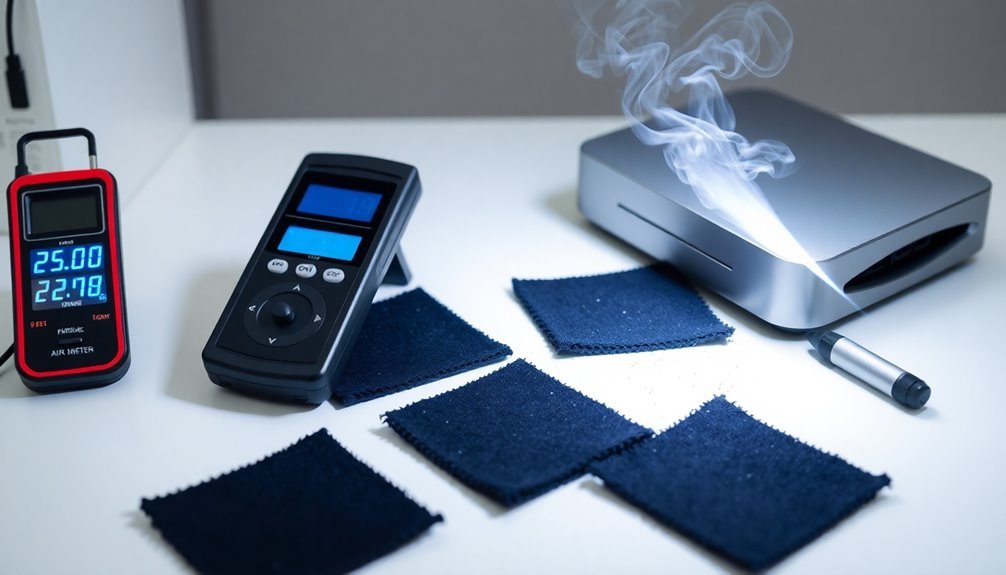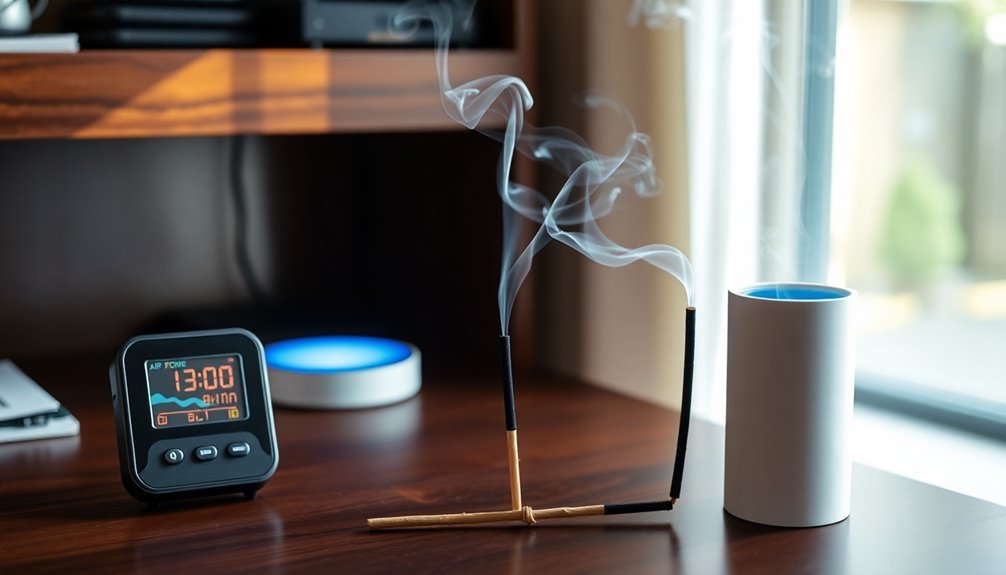To properly test your air ionizer's performance, start with a calibrated charged plate monitor (CPM) positioned 1200mm from the ionizer, ensuring no airflow obstructions. You'll want to select strategic test points that represent your critical process areas, documenting each location for consistent future testing. Don't forget to maintain regular performance verification by cleaning components with isopropyl alcohol and measuring both positive and negative discharge times. For best results, track your measurements over time to identify potential issues before they affect your operations. These fundamentals will set you up for more advanced testing techniques.
Proper Test Equipment Setup

Setting up your test equipment correctly is essential for accurate ionizer performance measurements.
You'll need a charged plate monitor (CPM) that meets ANSI/ESD STM3.1 and ANSI/ESD SP3.3 standards, equipped with a 15 cm by 15 cm isolated conductive plate. Your test circuit should maintain a total capacitance of 20 picofarads ± 2 picofarads.
Position your ionizer 1200 mm from the test surface, ensuring there aren't any airflow obstructions between them. You'll want to place your CPM at the center of the ionizing bar or at a consistently repeatable location. Ensure proper accuracy by using a PFM-711B fieldmeter with ±5% precision at standard conditions.
If you're using air-assist ionizers, set the input pressure to 207 kilopascals. Your test surface must be static dissipative or conductive and properly grounded. Don't forget to ground yourself as well.
When selecting test locations, focus on areas with critical processes and product placement. Make sure your equipment can measure voltage, decay time, temperature, and relative humidity in real-time. Modern ionizer test equipment like the Monroe 287B allows you to store up to ten tests for comprehensive analysis.
Document the CPM plate location carefully – you'll need this information for future compliance verification testing. For air-assist ionizing bars, conduct your tests using the actual airflow and pressure conditions of your application.
Strategic Testing Points
Before conducting your ionizer performance tests, carefully select strategic testing points based on your specific ionizer type and application. You'll need to take into account factors like ionizer length, environmental conditions, and the presence of laminar flow. For air assist bar ionizers, your test locations will vary depending on the bar's length, while soft x-ray and non-airflow alpha ionizers require different testing setups entirely. Clean air delivery rates should be measured to verify proper filtration effectiveness.
Position your charged plate monitor (CPM) at specified distances following STM3.1 guidelines, using the standard 15 cm x 15 cm isolated conductive plates. You'll want to focus on one or two test locations that best represent your end-user application for practical compliance verification. Standard room ionization installations require mounting bars 2000 mm apart on the ceiling for optimal coverage.
| Ionizer Type | Testing Considerations |
|---|---|
| Air Assist Bar | Length-based test points |
| Soft X-Ray | Specific setup requirements |
| Alpha (37.5-56 cm) | Multiple test locations |
| Alpha (>56 cm) | Extended coverage points |
Don't forget to account for your facility's environmental conditions, including compressed air pressures and air volume. Your interlock systems must be functional during testing, and you'll need to maintain consistent laminar flow conditions where applicable for accurate results.
Regular Performance Verification Methods

A regular verification process confirms your ionizer maintains peak performance over time.
You'll need to implement simplified test procedures that you can perform frequently using portable equipment, while still maintaining correlation with standard CPM measurements.
Regular cleaning of ionizer components with isopropyl alcohol solution helps ensure accurate test results.
When testing air-assist ionizing bars, make sure you're using the actual application airflow and pressure to get accurate results. You'll want to measure both the discharge time for positive and negative polarities and the offset voltage at each location.
For newer ionizer designs, you'll need to adapt your verification methods based on the specific technology.
Whether you're working with soft x-ray ionizers, non-airflow alpha ionizers, or air-assist bars, maintain similar test points and distances as outlined in ANSI/ESD STM3.1.
These periodic checks will indicate when you need to perform a full calibration using a CPM.
Remember to keep detailed records of your test points and results to track performance trends over time and confirm consistent measurement conditions.
Frequently Asked Questions
How Do Temperature and Humidity Variations Affect Ionizer Performance Test Results?
Your ionizer's test results will vary as temperature and humidity fluctuate. High temps reduce ion production, while high humidity neutralizes ions. You'll get the most accurate results between 20-30°C and 45-75% humidity.
Can Multiple Ionizers in Close Proximity Interfere With Individual Testing Accuracy?
Yes, nearby ionizers can disrupt your testing accuracy through EMI, overlapping ionization fields, and airflow interference. You'll need to maintain proper spacing and test units sequentially to get reliable performance measurements.
What Causes Sudden Spikes in Offset Voltage During Routine Testing?
You'll notice sudden offset voltage spikes due to emitter contamination, incorrect calibration, equipment malfunctions, or environmental changes. Regular maintenance and proper calibration checks will help prevent these unexpected voltage fluctuations during testing.
Should Ionizer Testing Protocols Change When Working With Different Material Surfaces?
Yes, you'll need to adapt your ionizer testing protocols for different materials since surface conductivity, charging characteristics, and discharge rates vary. Adjust your test distances and parameters to match each material's unique properties.
How Do Air Filtration Systems Impact Ionizer Discharge Time Measurements?
Your air filtration system's MERV rating and airflow directly affect ionizer discharge times. You'll notice longer discharge times with high-efficiency filters as they remove charged particles that could influence your measurements.
In Summary
Testing your air ionizer doesn't have to be complicated. You'll get reliable results by following proper equipment setup procedures, choosing strategic test points throughout your space, and implementing regular verification routines. When you stick to these three key steps, you can confidently monitor your ionizer's effectiveness and maintain ideal air quality in your environment. Make testing a consistent part of your maintenance schedule.





Leave a Reply